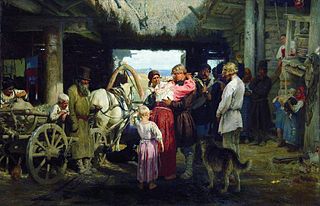
A non-commissioned officer (NCO) is a military officer who has not pursued a commission. Non-commissioned officers usually earn their position of authority by promotion through the enlisted ranks. In contrast, commissioned officers usually enter directly from a military academy, officer training corps (OTC) or reserve officer training corps (ROTC), or officer candidate school (OCS) or officer training school (OTS), after receiving a post-secondary degree.
Feldwebel is a non-commissioned officer (NCO) rank in several countries. The rank originated in Germany, and is also used in Switzerland, Finland, Sweden, and Estonia. The rank has also been used in Russia, Austria-Hungary, occupied Serbia and Bulgaria.
Oberfeldwebel is the fourth-lowest non-commissioned officer (NCO) rank in German Army and German Air Force.
Unteroffizier is a junior non-commissioned officer rank used by the Bundeswehr. It is also the collective name for all non-commissioned officers in Austria and Germany. It was formerly a rank in the Imperial Russian Army.

Wachtmeister is a military rank of non-commissioned officers (NCO) in Austria and Switzerland. The Wachtmeister was initially responsible for the guard duty of the army. Later, it became the Feldwebel equivalent NCO-grade of the cavalry and artillery. Besides Austria and Switzerland today, the rank was also used elsewhere, for example in Germany, Russia, and Poland (wachmistrz).
Fähnrich is an officer candidate rank in the Austrian Bundesheer and German Bundeswehr. The word Fähnrich comes from an older German military title, Fahnenträger, and first became a distinct military rank in Germany on 1 January 1899. However, Fähnrich ranks are often incorrectly compared with the rank of ensign, which shares a similar etymology but is a full-fledged commissioned officer rank.
Korporal is the German and Danish spelling of the English corporal. Korporal is used in a number of armed forces as the lowest rank of the non-commissioned officers group. However, in the German Bundeswehr, it is considered a high enlisted personnel rank. In Switzerland the rank is used in the Fire Department as well.

Zugführer is a military appointment to a sub-subunit leader, e.g. platoon leader, belonging to the Non-commissioned officer (NCO) rank group or junior officer. A Zugführer leads or commands normally a subunit that is called in German language Zug.
Oberwachtmeister (OWm) is in Austria and Switzerland a military rank of non-commissioned officers (NCO). Besides Austria and Switzerland today, the rank was also used for example in Germany and Russia.
Stabswachtmeister is in the Austrian Bundesheer a NCO-rank. As lowest grade of the Staff-NCO rank group he is normally dedicated to command a platoon or to serve in a military staff appointment. However, he might also be assigned to command a military squad.
The Military ranks of Austria are the military insignia used by the Austrian Armed Forces. Austria is a landlocked country and has no navy.
This article deals with the rank insignia of the Austro-Hungarian Army, as worn by the Austro-Hungarian Army after the reorganisation in 1867 until 1918.
Offiziersstellvertreter, short OStv, is a rank of the higher non-commissioned officers rank group in the Austrian Bundesheer and Imperial German Army.
Zugsführer is a rank of the enlisted men rank group in the Austrian Bundesheer. In comparison to the German Bundeswehr it is equivalent to the EN-rank “Oberstabsgefreiter”. A Zugsführer might be tasked to lead a sub-subunit of 8 to 13 soldiers.
Obermaat is a military rank of the Bundeswehr and earlier other German-speaking armed forces.
Hauptbootsmann designates in the German Navy of the Bundeswehr a military person or member of the armed forces. It belongs to the particular rank group Senior NCOs with port épée.
Stabsunteroffizier is a military rank of the German Bundeswehr. It was preceded by the rank Unterfeldwebel that was used between 1935 and 1945 in the armed forces of Nazi Germany, the Wehrmacht. The East German National People's Army used the rank Unterfeldwebel from 1956 to 1990. In the Austrian Armed Forces Stabsunteroffizier is the collective name to all higher Non-commissioned officers.
Vizeleutnant, short Vzlt, is a rank of the higher non-commissioned officers NCO rank group in the Austrian Bundesheer. The rank was introduced first from 1924 to 1938 and reused from 1956 onwards. It is the highest Stabsunteroffizier rank. It is grouped as OR9 in NATO, equivalent to a Sergeant Major in the United States Army / Chief Master Sergeant, and a Warrant Officer Class 1 in the British Army / Warrant officer.
Charge(s) used to be the generic term to the military ranks above the rank group of enlisted personnel in German speaking armies. In the today’s Austrian Armed Forces it is the designation to the rank group OR2 to OR4, which comprises the ranks Gefreiter, Korporal and Zugsführer.

Rekrut is the designation of a military appointment, position or status in German-speaking countries and in the 18th and 19th century Russian Empire that characterizes newly recruited or sought personnel during the initial period of the basic military training. However, in some countries, e.g. Austria and Switzerland, Rekrut might be the lowest rank of enlisted men, comparable to NATO OR-1.







